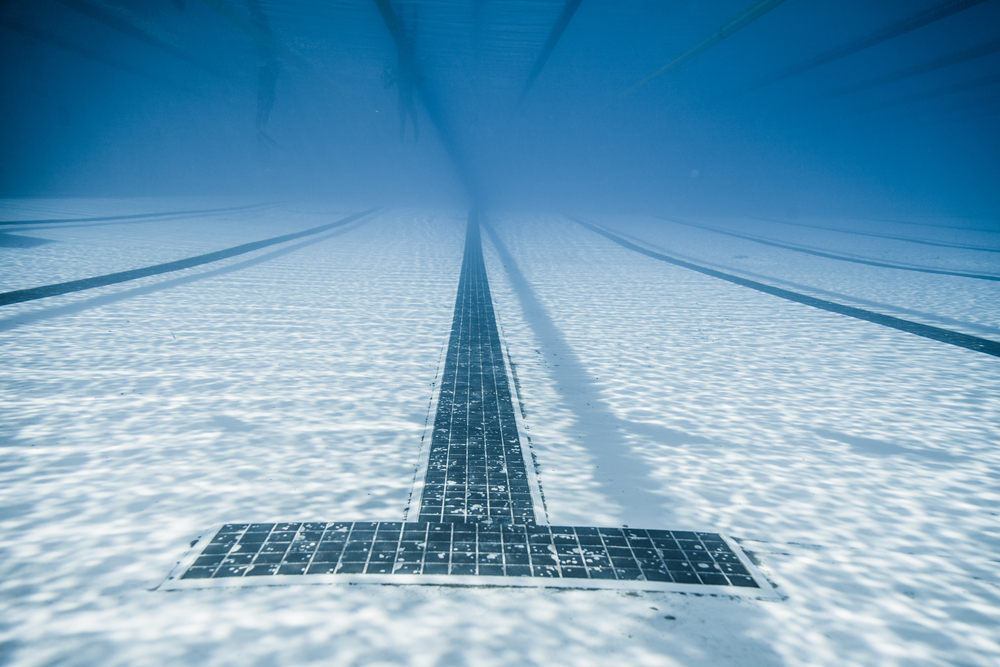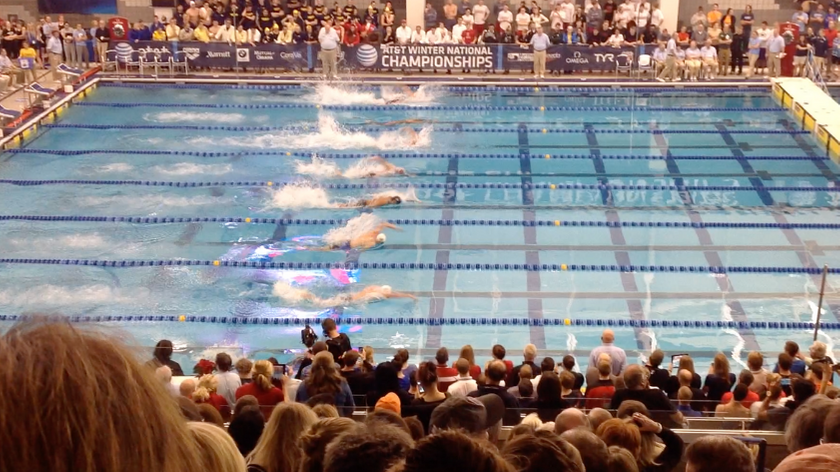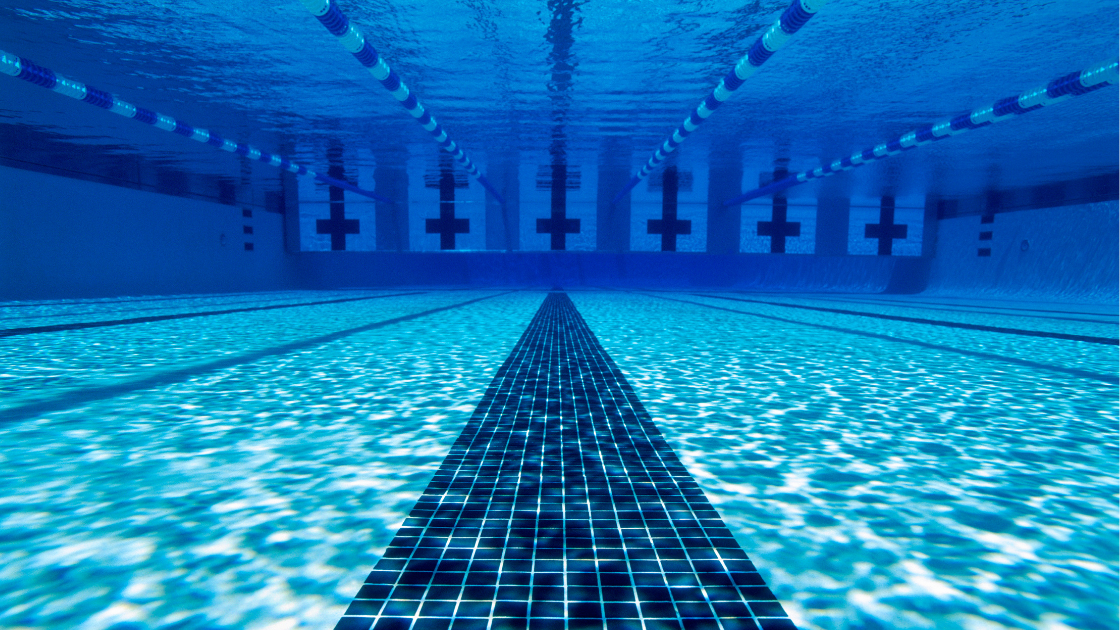Comparing Swimming Pool Filters
Does the type of swimming pool filter really matter? Are the differences between pool filters even noticable? How do they impact water quality? Does filter type have any affect on indoor air quality? At the end of the day, filters are filters that filter...right? Let's discuss.
Obviously, filtration impacts water quality, and perhaps that translates to air quality too. One thing we do know is more contaminants trapped in the filter means less contaminants circulating.
The Water Quality Triad
FACT: Water quality depends on three things working well:
- Circulation
- Filtration
- Chemistry
Ideal water quality requires all three of these, and they are interdependent. For instance: you could have perfect water chemistry and filtration...but if the pool was designed with poor circulation, water can still be cloudy and gross. Perhaps poor circulation creates dead zones in the pool, or simply does not recirculate water fast enough, so the filtration system cannot keep up with the bather demand. Filtration is only as good as the amount of water that passes through it. The same can be said for secondary systems for disinfection and oxidation.
Related: Pool Water Chemistry Resources
Types of swimming pool filters
We can divide all the types of filters out there in many different ways. For now, let's stick with media type, and subdivide from there. There three primary types of swimming pool filters: sand, cartridge, and D.E..
Sand Filters
Pressure sand filters are sealed vessels, usually about 1/2 to 2/3 full of [what should be] NSF/ANSI-Certified filter sand and, at the bottom of the filter, gravel. Recently, a new type of filter media, crushed glass, has become popular to take the place of sand. Most sand filters are what we call pressure sand, where water is pumped into the top of the sealed filter, and the water pressure pushes water down through the depths of sand and gravel (or glass), and eventually out through the bottom, through openings called laterals. See the diagram below of a Pentair pressure sand filter. The laterals are indicated by #24, and water comes in through the top inlets, indicated by #32.
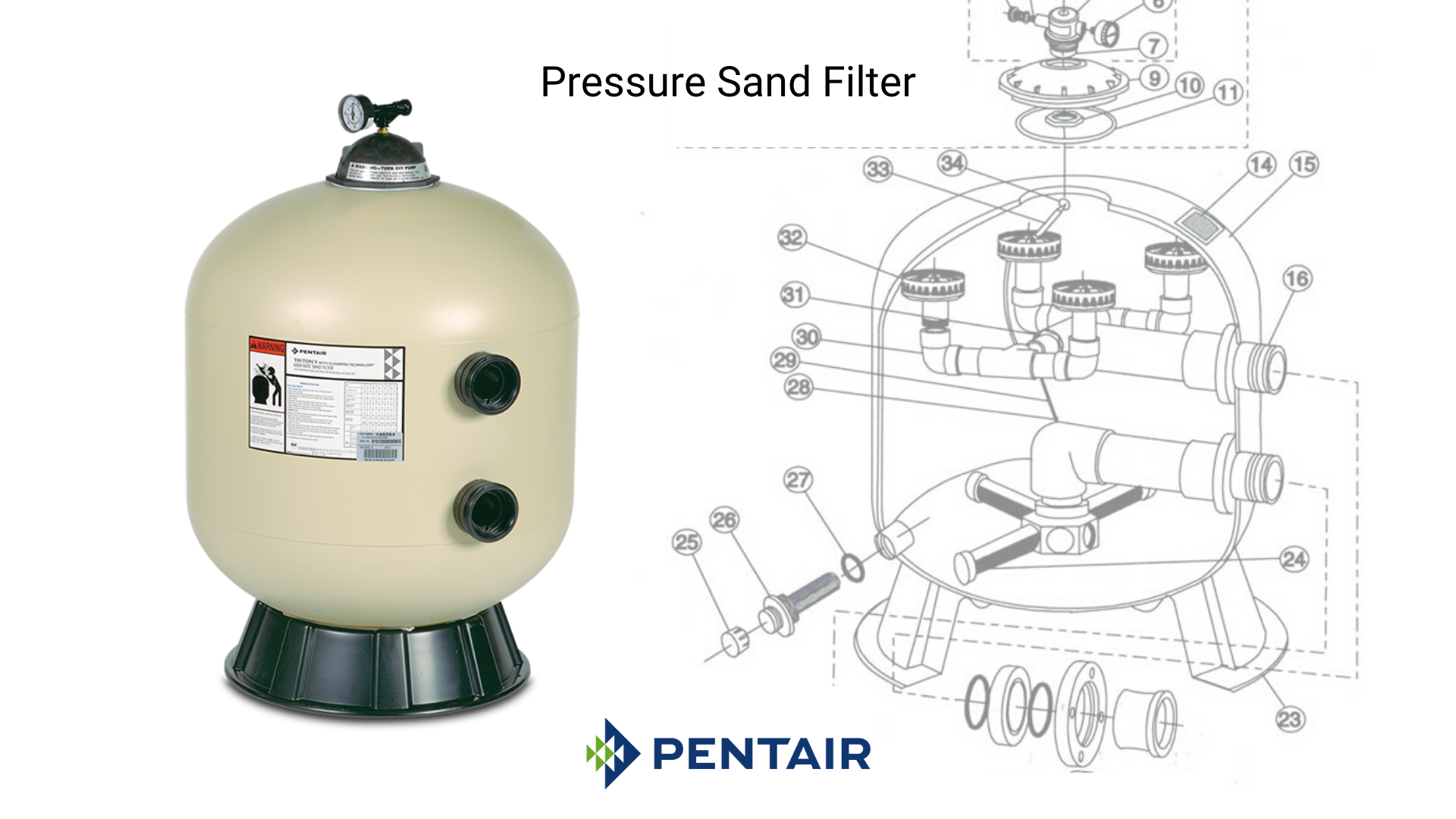
Pressure sand is probably the most common filter in the commercial swimming pool industry.
Vacuum sand filters are exclusively a commercial pool product, and can also serve as a surge tank. They were originally invented by Paddock Pool Equipment Company, and in the commercial pool market, are quite common nationwide. They are almost always built into the ground so you can walk over them, which allows for more walkability in the pump room. Rather than pushing water through sand and down through laterals, vacuum sand filters pull water down through the sand. Just like pressure sand filters, vac-sand filters can also use crushed glass media. See the diagram below of a Paddock vac-sand filter.
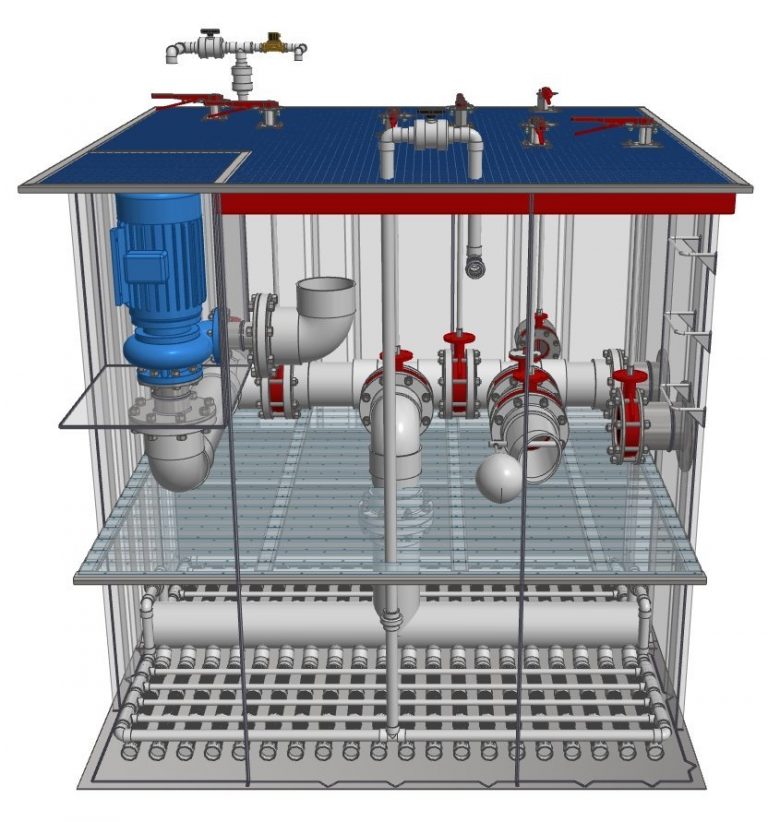
As you can see, the vacuum sand filter is more complicated, because it doubles as a surge tank. The laterals are at the very bottom, and sand would be in the bottom 1/3 of the pit. The laterals pull water down through the sand, which captures the non-living organics, oils, debris etc.
One thing we LOVE about the vac-sand filter from Paddock is that it integrates source-capture exhaust with a built-in Paddock Evacuator®. This is a custom exhaust that captures chloramine vapor from the open water and virtually prevents the rest of the pump room from being exposed to it.
Another thing we love about the vac-sand filter is the amount of surface area the sand has. This allows for less pressure, but more area to capture oils and debris. Check out this video of an Orenda enzyme and phosphate remover purge of one of these Paddock vac-sand filters, and the amount of oils they capture:
Pros and Cons for Sand Filters
These are usually the most affordable type of filter to purchase and and maintain. They are also easy to clean out particulates to waste, such as the sediment after removing phosphates from water. The cleaning cycle is called backwashing, which is when the operator reverses the direction of waterflow. Water pumps up from the bottom of the sand bed, and out the top to a waste line. Because of the ease of backwashing, maintaining sand filters is pretty straight forward and easy.
Pros: Affordable, easy to clean (backwashing), simple to use, and they last a very long time.
Cons: As shown in the graphic below, courtesy of Orenda Academy™, sand filters capture particles as small as 20-30 microns (µ), which means their filter screening ability is the weakest of all types of pool filters.
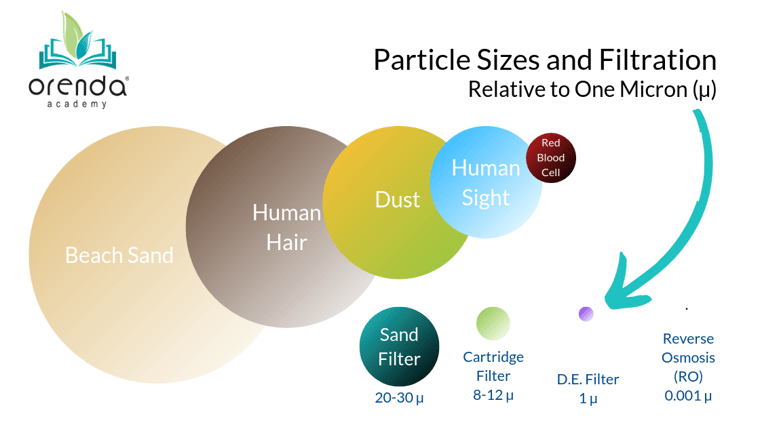
Smaller particles can pass through the filter, even though they are smaller than the human eye can see. But over time, water clarity can become an issue if the filter is not maintained and circulating properly (remember the water quality triad of circulation, filtration and chemistry). The other big con that the industry has believed for decades is that sand wears down over time...that in a matter of years (maybe up to 10 years or so), the sand will need to be replaced because it's too worn down and eroded. They say "the edges round off" and the sand loses its ability to trap particles. Well, this story is a "con" in every sense of the word. It's a myth. Sure, erosion is a real thing...but in just a few years, in a filter with virtually no turblance other than backwashing?
Look at the video above and judge for yourself. The problem isnt that sand wears down, it's that it gets fouled by years and years of contamination. It just needs to be cleaned and freed from the oils and 'body butter' that have made it disgusting. In fact, here's another video showing pressure sand filters being purged the same way as the vac-sand filter. The old sand feels just like new sand.
Cartridge Filters
Cartridge filters are very rarely used in commercial pools, and in our opinion, for good reason. They are common in residential pools with low bather loads, and their screening ability is better than that of a sand filter (down to 8-12µ particle size can be captured). But while clarity might be better for a while, cartidges tend to get dirty faster, and need to be cleaned. Unlike sand filters with a simple backwash function, cartridge filters must be opened, removed and manually cleaned. It takes time and effort, and it is not a fun job. On top of that, cartridges do not last very long compared to sand. Some need to be replaced more than once a year, depending on how the pool is used and maintained.
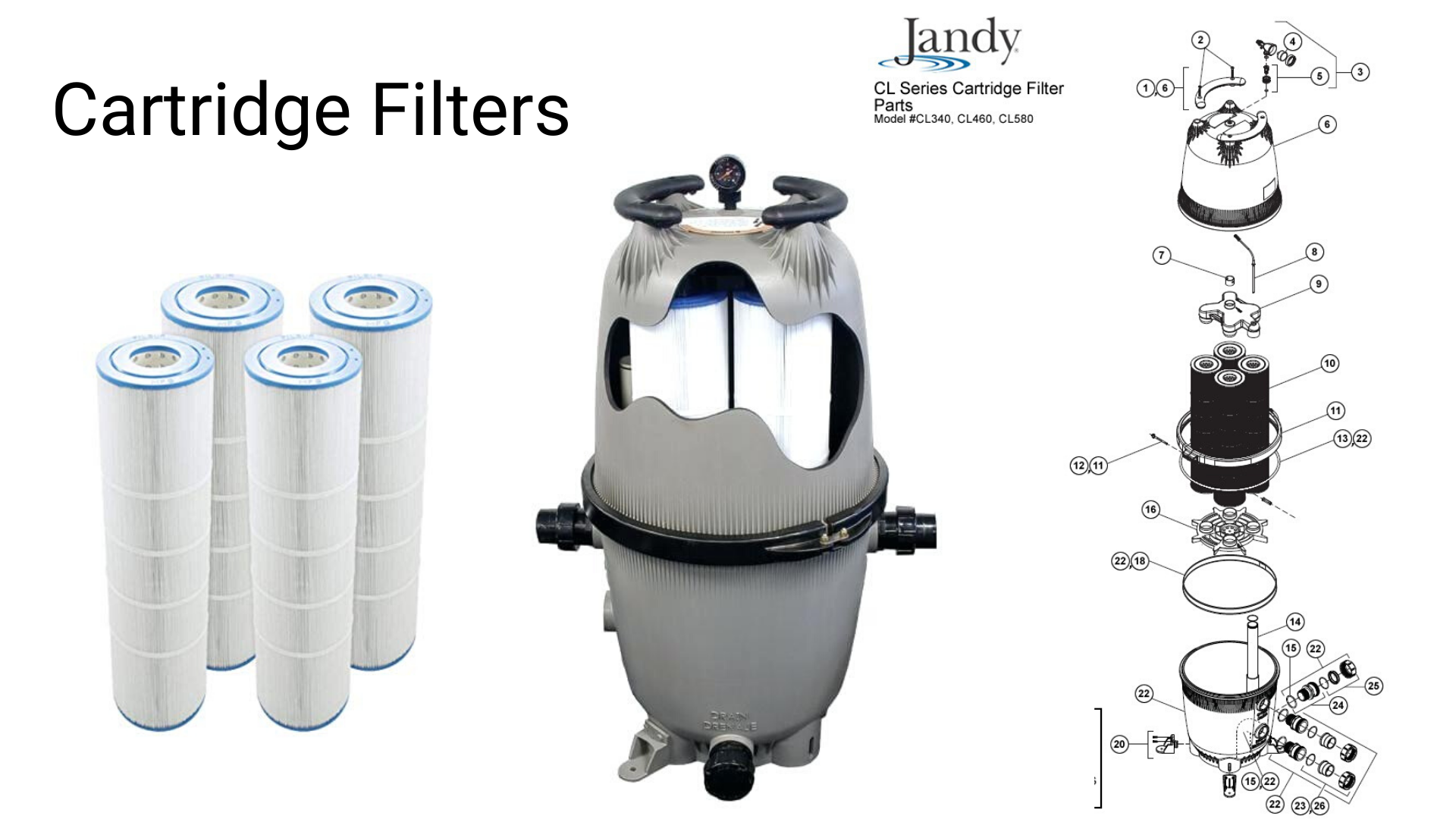
Pros: Simple installation, easy to use, good water clarity.
Cons: Laborous to clean (and the cartridges must be cleaned frequently), and their longevity before replacement cartridges is low.
Diatomaceous Earth (D.E.) Filters
D.E. Filters can capture particles as small as one micron (1µ). These filters have the best screening ability of any pool filter, hands down. Residential D.E. filters use a series of grids, similar to that of a cartridge filter. The difference is, the grids themselves need to be "charged" or coated with a powdered media called diatomaceous earth, or alternatively, perlite. The D.E. or perlite media is pulled into the filter through the skimmer, and coats the outside of the grids. The grids + media become the screening filter that captures just about anything and everything. Reference the size graphic above from Orenda Academy™ for a general size comparison of particles.
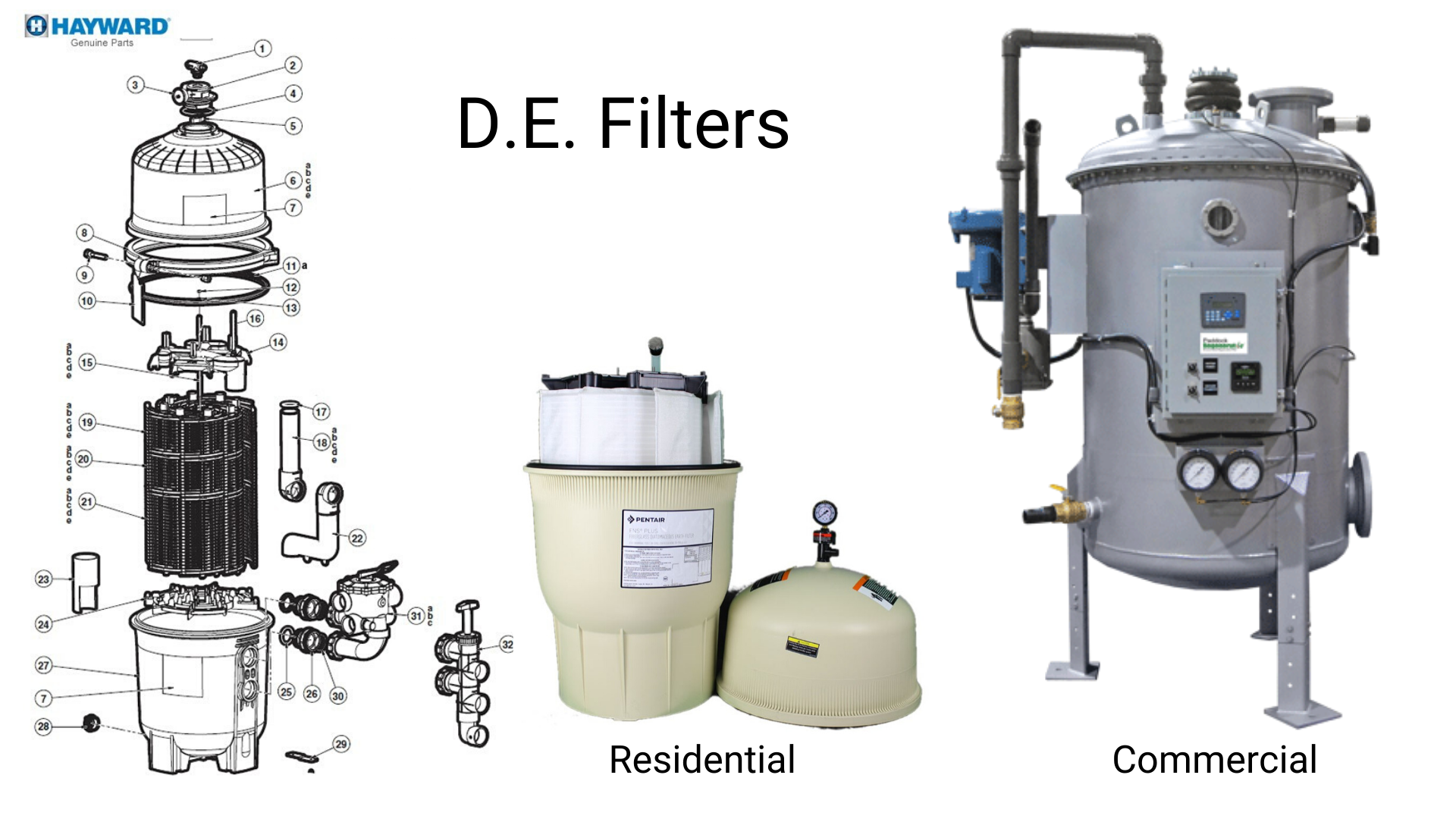
Commercial D.E. Filters are the most advanced, automated filters in the aquatic industry. These are the filters that the best aquatic venues and water parks are using. They automatically regenerate a fresh layer of perlite through a timed "bump" cycle, hence the name Regenerative D.E. Filter. Regenerative D.E. filters have their own variable frequency drives (VFDs) and can deliver some of the most stunning water quality imaginable:
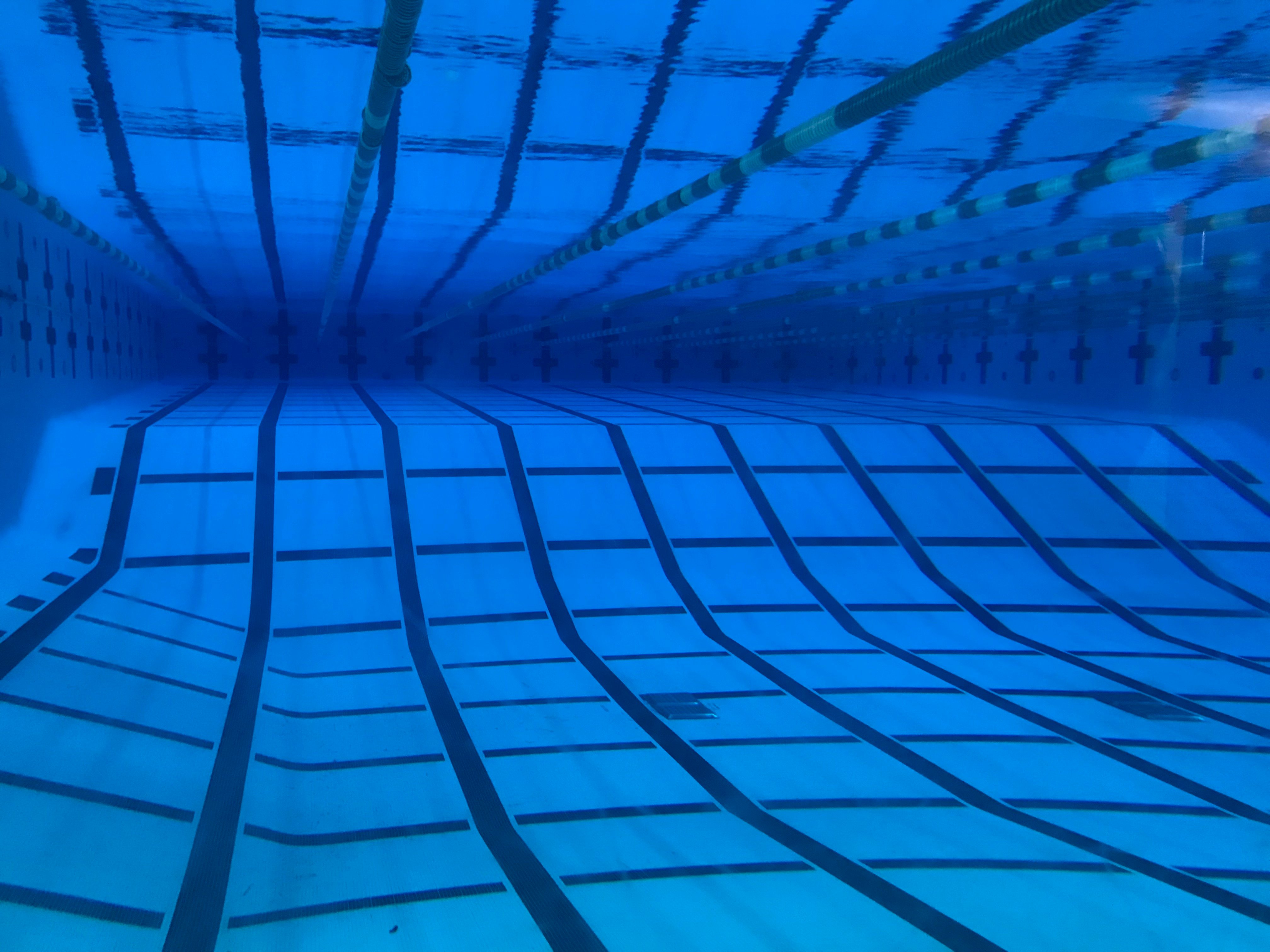
Both residential and commerical D.E. filters have to change out their media periodically, depending on the bather load and pressure that has built up.
Pros: The best screening ability (by far), [commercial] regenerative cycle is automated, optimal water clarity.
Cons: Most expensive filtration, periodic media dumps/replacements, and while they are automated, they are also more complicated to operate.
Conclusion
At the beginning of this article, we asked rhetorical questions. Does the type of filter really matter? Yes. Are the differences between pool filters even noticeable?Over time, yes. It depends on how often you use the pool and how well you're paying attention to the water clarity. How do filters impact water quality? Their screening ability determines the size of particles each filter can capture, which has a direct relationship to water clarity and water quality. Does filter type have any affect on indoor air quality? This is hard to say, because chloramine production is about the removal of nitrogen and organic compounds by chlorine, which are small enough to pass through filtration. Pools with all types of filters have chloramine problems. Then again, less contaminants circulating can reduce chlorine's burden, so perhaps there is somewhat of a correlation.
Hopefully this article helped explain the three types of swimming pool filtration. If you want to learn more, contact their manufacturers. And if you have water chemistry or air quality concerns with your pools, feel free to contact us directly.

 By
By
